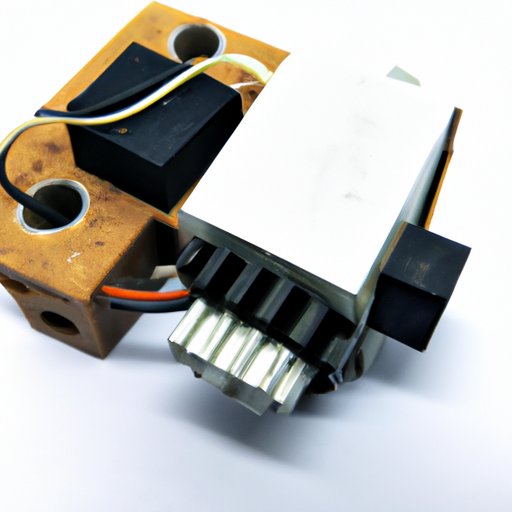Introduction
A solenoid is an electromagnetic device that creates a magnetic field when current passes through it. It is made up of a coil of insulated wire wound around a core or rod of iron or other ferromagnetic material. The current passing through the coil creates a strong magnetic field that can be used to move or activate other objects. In this article, we will explore how does a solenoid work, from the basics of its operation to its various applications.
Explaining the Physics of a Solenoid
In order to understand how a solenoid works, it is important to first understand the basic principles of electric and magnetic fields. An electric field is a force field generated by a charged particle, such as an electron or proton. This field exerts a force on other particles with the same charge, pushing them away or pulling them closer depending on the type of charge. A magnetic field is created when electric current passes through a conductor, such as a wire or coil, and produces a magnetic force.
The relationship between electricity and magnetism was first described by Michael Faraday in 1831. He discovered that when a current passes through a wire, it creates a magnetic field around the wire, and when a magnet is moved near the wire, it induces a current in the wire. This phenomenon is known as electromagnetic induction and is the basis for how a solenoid works.
A Step-by-Step Guide to How a Solenoid Works
A solenoid is essentially an electromagnet. When current passes through the coils of wire, it creates a magnetic field around the core. This magnetic field is attracted to the core, causing it to move. The movement of the core is what causes the solenoid to activate and do work.
The basic components of a solenoid are the core, the coils of wire, and the electrical power source. The core is usually made of iron or another ferromagnetic material and is the part that moves when the solenoid is activated. The coils of wire are wrapped around the core and connected to an electrical power source, such as a battery or AC power. When current passes through the coils, it creates a magnetic field around the core which attracts it, causing it to move.
The Basics: What is a Solenoid and How Does it Work?
A solenoid is an electromechanical device that uses an electric current to create a magnetic field. This magnetic field is then used to move or activate other objects. Solenoids are used in a variety of applications, from controlling valves to operating door locks.
There are several types of solenoids, including linear, rotary, and push-pull. Linear solenoids use a plunger or core that moves in a straight line when activated. Rotary solenoids use a rotating armature or core, while push-pull solenoids use two plungers that move in opposite directions.

Solenoid Applications in Everyday Technology
Solenoids are used in a wide range of everyday technologies, from home appliances to automotive engineering. They are used to control a variety of functions, such as starting and stopping motors, controlling valves, and actuating switches.
In the automotive industry, solenoids are used in fuel injection systems, ignition systems, and relay switching. In home appliances, they are used in washing machines and dishwashers to control water flow, and in refrigerators to control temperature. In industrial machinery, they are used to control valves, conveyor belts, and other automated processes.
Solenoids: How They’re Used in Automotive Engineering
Solenoids are widely used in the automotive industry for a variety of purposes. In fuel injection systems, solenoids are used to control the amount of fuel injected into the engine. They are also used in ignition systems to control spark timing and in relay switching to activate or deactivate certain components.
Solenoids are also used in automatic transmission systems to control the shifting of gears. They are used to engage and disengage the clutch and to shift the gears to the appropriate speed. Solenoids are also used in anti-lock braking systems to control the brakes, as well as in airbag systems to deploy the airbag in the event of an accident.
Conclusion
Solenoids are an essential component of many everyday technologies, from home appliances to automotive engineering. They are used to control a variety of functions, such as starting and stopping motors, controlling valves, and actuating switches. By understanding how a solenoid works and its various applications, we can better appreciate the role it plays in our lives.
The benefits of using solenoids are numerous, from improved efficiency to increased safety. They are reliable, easy to maintain, and cost-effective. With their wide range of applications, solenoids are here to stay and will continue to be an integral part of our lives.
(Note: Is this article not meeting your expectations? Do you have knowledge or insights to share? Unlock new opportunities and expand your reach by joining our authors team. Click Registration to join us and share your expertise with our readers.)
